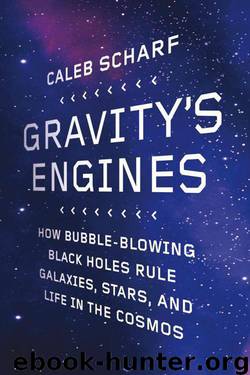Gravity's Engines by Caleb A. Scharf

Author:Caleb A. Scharf [Scharf, Caleb A.]
Language: eng
Format: epub
Tags: Non-Fiction, Science, (¯`'•.¸//(*_*)\\¸.•'´¯)
ISBN: 9780374114121
Publisher: Scientific American / Farrar, Straus and Giroux
Published: 2012-08-07T00:00:00+00:00
Figure 14. An X-ray image of the hot gas in the inner regions of the Perseus galaxy cluster, showing the dark bubbles that have been blown by the black hole at the center and the great ripples of sound waves set in motion across the structure. At the very center are signs of some darker, cooler gas, looking like dirty strands of coagulated matter.
*
Fabian himself is an avid rower. More often than not, if you’re taking a morning stroll along the banks of the River Cam passing through Cambridge, you’ll spot his boat skimming along the gently flowing water, its V-shaped ripples expanding outward, lapping softly at the riverbank. Watch him move upriver, and you see the same processes at work that are taking place in Perseus. As the boat pushes and displaces the fluid around it, some of that energy dissipates across the water, far away from its source. The lap and splash of the shoreline waves comes from energy that is generated within the muscle fibers of human arms and transferred across a river’s surface. The supermassive black hole in a cluster core does the very same thing.
These structures in Perseus help us understand how the central supermassive black hole holds cooling matter at bay. The buoyantly rising bubbles can lift and push cooling gas aside, preventing it from funneling all the way down to the core. And like a vast musical organ, the bubbles set sound waves in motion that can disperse energy throughout Perseus, keeping it at a perfect simmer. We don’t yet know if these rippling pressure waves, like the rolling thunderclaps of a distant storm, are entirely responsible for halting the flow of cooling gas into Perseus’s inner core. But if we carefully measure these waves and compute how much energy they can push out across the cluster, it is certainly enough to balance out the energy that the cooling gas loses in X-rays.
A simple physics experiment brings the principle to life: place an open loudspeaker from a music system so that the speaker is on its back, forming a shallow cup. Put a sprinkling of sand or rice grains on the speaker. They roll and slither down to the middle. But then play music through the speaker with the volume turned up, perhaps a good bit of Bach or some heavy metal. The bass notes (or longer sound waves) vibrate the speaker and push at the grains. If you find the right pitch and volume, they’ll spread back out up the sides of the cup, bouncing and agitated and unable to slump to the center, just like the gas in Perseus.
Every few million years a supermassive black hole in Perseus is being fed matter. When this happens, an outburst of energy from its jets and radiation inflates bubbles of high-pressure, fast-moving particles into the comparatively cooler and denser gas of the cluster. As these bubbles inflate, they act like the vibrating blast from a massive pipe organ, pushing off a rippling pressure wave that spreads out across the system.
Download
This site does not store any files on its server. We only index and link to content provided by other sites. Please contact the content providers to delete copyright contents if any and email us, we'll remove relevant links or contents immediately.
| Aeronautics & Astronautics | Astronomy |
| Astrophysics & Space Science | Comets, Meteors & Asteroids |
| Cosmology | Mars |
| Solar System | Star-Gazing |
| Telescopes | UFOs |
Tools of Titans by Timothy Ferriss(8305)
Turbulence by E. J. Noyes(7980)
Secrets of Antigravity Propulsion: Tesla, UFOs, and Classified Aerospace Technology by Ph.D. Paul A. Laviolette(5333)
Astrophysics for People in a Hurry by Neil DeGrasse Tyson(5151)
Room 212 by Kate Stewart(5072)
Design of Trajectory Optimization Approach for Space Maneuver Vehicle Skip Entry Problems by Runqi Chai & Al Savvaris & Antonios Tsourdos & Senchun Chai(5037)
Pale Blue Dot by Carl Sagan(4956)
The David Icke Guide to the Global Conspiracy (and how to end it) by David Icke(4657)
A Journey Through Divination and Astronomy by Publishing Pottermore(4363)
Goodbye Paradise(3762)
Apollo 8 by Jeffrey Kluger(3668)
COSMOS by Carl Sagan(3589)
The Five People You Meet in Heaven by Mitch Albom(3520)
Losing the Nobel Prize by Brian Keating(3518)
How to Read Water: Clues and Patterns from Puddles to the Sea (Natural Navigation) by Tristan Gooley(3433)
Brief Answers to the Big Questions by Stephen Hawking(3393)
How to Read Nature by Tristan Gooley(3292)
The Order of Time by Carlo Rovelli(3162)
A Brief History of Time by Stephen Hawking(2992)
